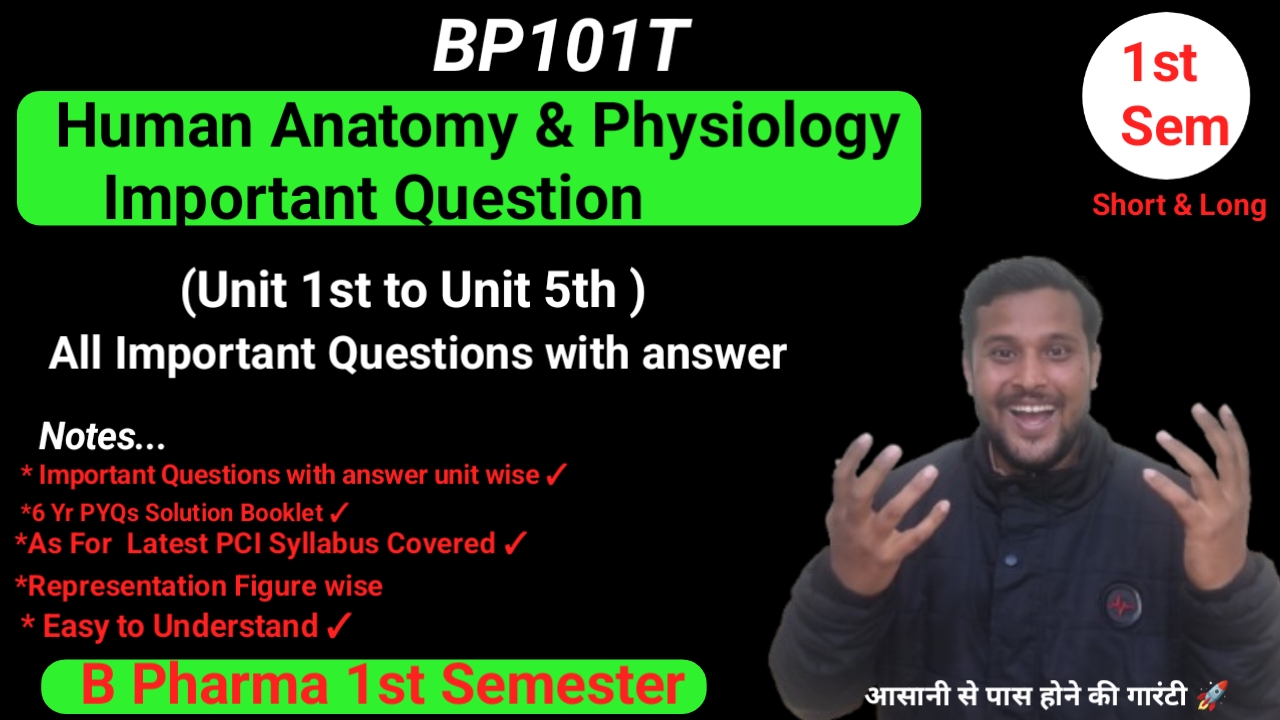HAP Important Questions | B Pharma 1st Semester ( BP101T)
Description
Here's a concise and helpful guide for "HAP Important Questions" (Human Anatomy and Physiology - BP101T) for B. Pharma 1st Semester, with short-selling descriptions suitable for quick revision or last-minute preparation.
HAP (BP101T) Important Questions – Short Selling Description
🧠 Unit 1: Introduction to Human Body
1. Define anatomy and physiology.
→ Anatomy: Study of body structures.
→ Physiology: Study of body functions.
2. Levels of structural organization in the human body
→ Chemical → Cellular → Tissue → Organ → System → Organism.
3. Homeostasis and its importance
→ Maintains internal stability (e.g., temperature, pH, etc.).
4. Anatomical positions and planes
→ Standard body posture; planes: sagittal, frontal, transverse.
💀 Unit 2: Skeletal System
1. Functions of the skeletal system
→ Support, protection, movement, blood cell formation.
2. Classification of bones
→ Long, short, flat, irregular, sesamoid.
3. Structure of a long bone
→ Diaphysis, epiphysis, medullary cavity, periosteum.
4. Types of joints
→ Fibrous, cartilaginous, synovial (hinge, ball-and-socket).
💪 Unit 3: Muscular System
1. Types of muscle tissue
→ Skeletal (voluntary), cardiac (involuntary), smooth (involuntary).
2. Sliding filament theory
→ Explains muscle contraction via actin and myosin interaction.
3. Neuromuscular junction
→ Synapse between neuron and muscle fiber.
4. Muscle fatigue
→ Caused by lactic acid buildup due to anaerobic respiration.
❤️ Unit 4: Cardiovascular System
1. Structure of the heart
→ 4 chambers: 2 atria, 2 ventricles; valves ensure one-way flow.
2. Cardiac cycle
→ Sequence: atrial systole, ventricular systole, diastole.
3. ECG and its significance
→ Records electrical activity of heart; P, QRS, T waves.
4. Blood pressure: definition & normal values
→ Normal: 120/80 mmHg.
🩸 Unit 5: Blood and Lymph
1. Composition of blood
→ Plasma + formed elements (RBCs, WBCs, platelets).
2. Functions of blood
→ Transport, regulation, protection.
3. Blood groups (ABO system)
→ A, B, AB, O – based on antigen presence.
4. Hemostasis
→ Process of blood clotting to prevent bleeding.
🫁 Unit 6: Respiratory System
1. Parts of the respiratory system
→ Nose → Pharynx → Larynx → Trachea → Bronchi → Lungs.
2. Mechanism of breathing
→ Inspiration (active), expiration (passive).
3. Lung volumes and capacities
→ TV, IRV, ERV, VC, etc.
4. Gas exchange
→ Occurs in alveoli by diffusion.
🍽️ Unit 7: Digestive System
1. Organs of the digestive system
→ Mouth to anus; includes accessory glands.
2. Digestive enzymes and their functions
→ Amylase, lipase, pepsin, etc.
3. Role of liver and pancreas
→ Liver: bile production; Pancreas: enzymes, insulin.
4. Absorption of nutrients
→ Mainly occurs in the small intestine.
🧠 Unit 8: Nervous System
1. Structure of a neuron
→ Cell body, axon, dendrites.
2. Central vs Peripheral Nervous System
→ CNS: brain & spinal cord; PNS: nerves.
3. Reflex arc
→ Involuntary response path: receptor → sensory → CNS → motor → effector.
4. Functions of brain parts
→ Cerebrum: thinking, Cerebellum: balance, Medulla: vital functions.
🌸 Unit 9: Endocrine System
1. Endocrine vs Exocrine glands
→ Endocrine: hormones to blood; Exocrine: ducts.
2. Major endocrine glands & hormones
→ Pituitary (GH), Thyroid (T3/T4), Adrenal (Adrenaline), Pancreas (Insulin).
3. Hormonal regulation examples
→ Blood sugar by insulin/glucagon.
🧪 Unit 10: Special Senses
1. Structure of the eye and its parts
→ Cornea, lens, retina, optic nerve.
2. Mechanism of vision
→ Light → retina → impulses → brain.
3. Structure of the ear
→ Outer, middle, inner ear.
4. Hearing mechanism
→ Vibrations → cochlea → nerve signals.
Loading...

